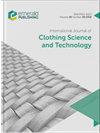Identifying leather type and authenticity by optical coherence tomography
IF 1
4区 工程技术
Q3 MATERIALS SCIENCE, TEXTILES
International Journal of Clothing Science and Technology
Pub Date : 2023-11-07
DOI:10.1108/ijcst-11-2022-0159
引用次数: 0
Abstract
Purpose This study aims to identify leather type and authenticity through optical coherence tomography. Design/methodology/approach Optical coherence tomography images taken from genuine and faux leather samples were used to create an image dataset, and automated machine learning algorithms were also used to distinguish leather types. Findings The optical coherence tomography scan results in a different image based on leather type. This information was used to determine the leather type correctly by optical coherence tomography and automatic machine learning algorithms. Please note that this system also recognized whether the leather was genuine or synthetic. Hence, this demonstrates that optical coherence tomography and automatic machine learning can be used to distinguish leather type and determine whether it is genuine. Originality/value For the first time to the best of the authors' knowledge, spectral-domain optical coherence tomography and automated machine learning algorithms were applied to identify leather authenticity in a noncontact and non-invasive manner. Since this model runs online, it can readily be employed in automated quality monitoring systems in the leather industry. With recent technological progress, optical coherence tomography combined with automated machine learning algorithms will be used more frequently in automatic authentication and identification systems.光学相干层析识别皮革类型和真伪
目的利用光学相干层析技术鉴别皮革的种类和真伪。设计/方法/方法使用从真皮和人造皮革样品中获取的光学相干断层扫描图像来创建图像数据集,并且还使用自动机器学习算法来区分皮革类型。结果光学相干层析扫描根据不同的皮革类型得到不同的图像。这些信息被用于光学相干断层扫描和自动机器学习算法正确地确定皮革类型。请注意,这个系统也可以识别皮革是真的还是合成的。因此,这表明光学相干断层扫描和自动机器学习可以用来区分皮革类型并确定它是否是真品。据作者所知,光谱域光学相干断层扫描和自动机器学习算法首次被用于以非接触和非侵入性的方式识别皮革的真伪。由于该模型在线运行,它可以很容易地应用于皮革行业的自动化质量监控系统。随着近年来技术的进步,光学相干断层扫描与自动机器学习算法的结合将在自动认证和识别系统中得到更频繁的应用。
本文章由计算机程序翻译,如有差异,请以英文原文为准。
求助全文
约1分钟内获得全文
求助全文
来源期刊
CiteScore
2.40
自引率
8.30%
发文量
51
审稿时长
10 months
期刊介绍:
Addresses all aspects of the science and technology of clothing-objective measurement techniques, control of fibre and fabric, CAD systems, product testing, sewing, weaving and knitting, inspection systems, drape and finishing, etc. Academic and industrial research findings are published after a stringent review has taken place.

 求助内容:
求助内容: 应助结果提醒方式:
应助结果提醒方式:


